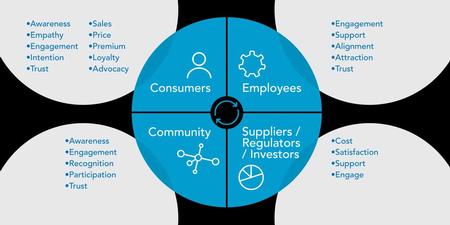
Across sectors, stakeholders increasingly demand accountability, expect value for money and frequently prefer to support businesses and organizations with proven social impact. According to an upcoming Nielsen report “Sustainable Shoppers Buy the Change They Wish To See In The World - 81% of global respondents feel strongly that companies should help improve the environment, and 49% say they’re inclined to pay higher-than-average prices for products with high-quality/safety standards, which consumers often associate with strong sustainability practices.” Several institutional- and regulatory-level changes are catalyzing this transition. Released by the US SIF Foundation, the 2016 Report on Sustainable and Responsible Investing Trends (SRI) in the United States, which measures activity of investors that apply various environmental, social and governance (ESG) criteria in their investment analysis and investors or money managers that filed or co-filed shareholder resolutions on ESG issues at publicly traded companies, after eliminating double-counting for assets involved in both strategies, shows that the overall total of SRI investing reached $8.1 trillion, a staggering 33 percent growth since 2014 with total SRI assets reaching $8.72 trillion. According to work done by the Initiative for Responsible Investment, governments and stock exchanges in 41 countries across the world have mandated sustainability reporting. Given this, in combination with consumers backing it up with their wallets, is certainly a positive sign. In addition to the evolving regulatory frameworks, there is a prevailing sense globally that there are real benefits for organizations to invest in sustainability. While organizations have always been expected to act responsibly and take care of communities, a world that is becoming increasingly aware and demanding more from organizations to be ‘responsible’ has heightened implications for corporate reputations. In this world of social media and instant sharing, organizations are coming to terms with the link between their actions as ‘responsible businesses’ and business outcomes. Encouraged by the rising importance of added ‘social value’ many public, private and nonprofit organizations are now beginning to take a ‘triple bottom line’ approach (economic, social and environmental, otherwise referred to as ‘people, planet, profit’) in measuring business success. That said, there does not exist a comprehensive mechanism to measure actual consumer behavior vis-à-vis how are they rewarding or punishing companies from the perspective of how responsible are those companies. Consumer facing businesses have not been able to put in place protocols and processes to quantify the result of their efforts around sustainability. But we are beginning to see trends that validate some of these notions. Data from Nielsen indicate such a trend. There are some who argue that organizations make a great deal of money and thus should give back some of that money and do good for the sake of doing good, without concern for measuring success or calculating impact on the triple bottom line. This could be connected to the fear or perception of the capitalistic nature of organizations—that they would try to maximize the return on their investment, which may then impair their ability to support initiatives that are critical to the world at large but may not provide as much return to the organization investing in it. The majority, however, and perhaps for good reasons, support the opposite perspective. Measuring impact of corporate actions on all the three parameters is considered critical to ensure that limited resources are utilized most efficiently to make a real difference. Measuring outcomes Focusing on socially responsible business practices, activities, and developing products with a socially beneficial element, has the potential to determine how successful a given organization is in the long term. Incorporating aspects of a robust measurement framework with a more standardized analysis may provide insight into the tangible results businesses realize that can be attributed to CSR activities. Building a mechanism to gauge consumers’ preferences for causes and integrating that with a measurement framework across all stakeholders of an organization could look like this: Within each of the four segments, we must measure a variety of factors using qualitative and quantitative methods to determine the impact of a business' social activities. The output will determine the value added by CSR activities, as well as inform approaches to improve relations between the organization and its stakeholders (consumers, community, suppliers/regulators/investors and employees), while providing a more robust picture of performance as a basis for management and strategic decision-making. Resources Arvidson, A., Lyon, F., McKay, S., and Moro, D. (2012) Valuing the Social? The nature and controversy of measuring Social Return on Investment (SROI) Voluntary Sector Review, Vol. 4, No. 1. Cabinet Office of the Third Sector. Social Return on Investment: an introduction. London, England. Emerson, J. and Cabaj, M. (2000) Social Return on Investment. Making Waves 11.2 Eurodiaconia. (2014) Measuring Social Value: What do we mean by measuring social value? Brussels, Belgium. The New Economics Foundation Consulting. Social Return on Investment (SROI): Measuring your wider impact helps you understand and promote your real value. London, England. The New Economics Foundation Consulting. (2004) Measuring Social Impact: the foundation of social return on investment. SROI Primer. Millar, R., and Hall, K. (2012) Social Return on Investment (SROI) and Performance Measurement. Public Management Review, 15:6, 923-941. Shubha, Kumar. (2014) Social Return on Investment (SROI) Analysis: An Innovative Framework for Measuring the Impact of One Health. GGRF Davos Planet@Risk, Vol. 2, No. 3, Special Issue on One Health (Part I/II) Social Ventures Australia. (2012) Social Return on Investment: Lessons learned in Australia. Prepared for Investing in Impact Partnership.
Making Intangibles Tangible: Who is to Blame When Brands are Written Down?
September 11, 2019
